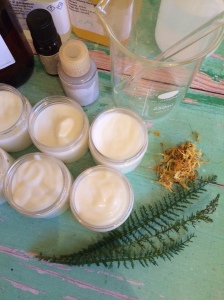
I’ve been thinking about an ointment that can be put on wounds, cuts, scrapes, grazes or ulcers. Dedj’s Duck Poo contains arnica, so can’t go on open wounds. It works amazingly on bruises, bashes, sprains, strains and the like, though. Now, if I had an ointment or a cream that worked as well as that for open wounds, that would be a fine thing.
I tried two ideas, using the Duck Poo ratio of oil parts to aqueous parts, and making it slightly less hard, so using less beeswax. Here you see the results.
I had made a deep decoction of Achillea millefolium, a wonderful vulnerary, which smells deep, dark and delicious. This I used as the aqueous component for both, and I used organic Symphytum officinale, also an extremely effective wound-healer, in the form of infused oil in both, with organic beeswax. The ratios are roughly 30 oil, 10 aqueous, 2 beeswax. Then add whatever you think will give it a little extra something.
 I had recently acquired some Shilajit capsules – Shilajit is supposed to be a wonder-healer, developed, I think, from some kind of resin. It’s difficult to get reliable information on it – the one leaflet I read (and bought!) was written by someone who made up spelling, syntax and grammar as she went along, so I didn’t even begin to trust her research. Hey ho. Anyone who knows more about this substance, please get in touch. I cracked open 15 capsules, which on my scales did not add up to even 1g, and added that to 10g Achillea, and put them in a bain marie to heat. 29g of Symphytum oil were added to 2g of beeswax, and they were also heated to melt the beeswax. The Shijalit expanded immediately in the deep decoction so the mixture became very stiff, and stuck to spoon and glass, hardening quickly. It took some stirring when the oil and beeswax were added, to break up the consistency and scrape it off the walls of the glass. When it felt as if the Shijalit had been suspended sufficiently not to ruin my coffee frother, I frothed until the mixture turned gleaming and fairly smooth. Here is the result: a wonderfully dark ointment with “bits” of Shijalit in it. Shall try it out on an unsuspecting (grown-up) child (of mine) this evening. He has a big scrape on his elbow from heroically avoiding a suicidal run-out in cricket.
I had recently acquired some Shilajit capsules – Shilajit is supposed to be a wonder-healer, developed, I think, from some kind of resin. It’s difficult to get reliable information on it – the one leaflet I read (and bought!) was written by someone who made up spelling, syntax and grammar as she went along, so I didn’t even begin to trust her research. Hey ho. Anyone who knows more about this substance, please get in touch. I cracked open 15 capsules, which on my scales did not add up to even 1g, and added that to 10g Achillea, and put them in a bain marie to heat. 29g of Symphytum oil were added to 2g of beeswax, and they were also heated to melt the beeswax. The Shijalit expanded immediately in the deep decoction so the mixture became very stiff, and stuck to spoon and glass, hardening quickly. It took some stirring when the oil and beeswax were added, to break up the consistency and scrape it off the walls of the glass. When it felt as if the Shijalit had been suspended sufficiently not to ruin my coffee frother, I frothed until the mixture turned gleaming and fairly smooth. Here is the result: a wonderfully dark ointment with “bits” of Shijalit in it. Shall try it out on an unsuspecting (grown-up) child (of mine) this evening. He has a big scrape on his elbow from heroically avoiding a suicidal run-out in cricket.
 The second batch was made with double the quantities of everything and 10g of Commiphora molmol (Myrrh) powder instead of the Shijalit. It looked about double the Shilajit in bulk, and I am wondering whether my scales were having a sulk when I was weighing the Shilajit. I usually put Myrrh powder on open wounds, so this may be a more efficient way of doing it. This time the powder didn’t bulk up so much in the deep decoction, but the result is still grainy. Frothing it was fairly easy as you can see here. Again, I shall experiment this evening for results.
The second batch was made with double the quantities of everything and 10g of Commiphora molmol (Myrrh) powder instead of the Shijalit. It looked about double the Shilajit in bulk, and I am wondering whether my scales were having a sulk when I was weighing the Shilajit. I usually put Myrrh powder on open wounds, so this may be a more efficient way of doing it. This time the powder didn’t bulk up so much in the deep decoction, but the result is still grainy. Frothing it was fairly easy as you can see here. Again, I shall experiment this evening for results.
 Here you can see the finished Commiphora molmol nestling gleamingly in its tin, and if you look carefully you can see flecky bits residing within. Both these ointments will suit the “It looks so disgusting it must be doing me good” tribe, closely related to the “No pain, no gain” family.
Here you can see the finished Commiphora molmol nestling gleamingly in its tin, and if you look carefully you can see flecky bits residing within. Both these ointments will suit the “It looks so disgusting it must be doing me good” tribe, closely related to the “No pain, no gain” family.





